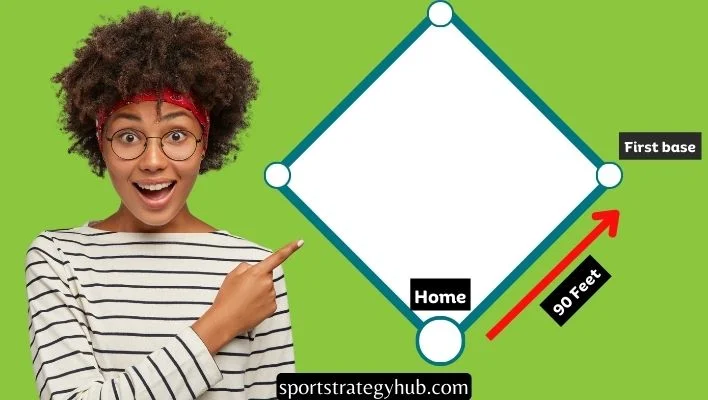How Far Is Home to First in Baseball: Distance Between Bases
Baseball captivates audiences with its strategic depth and compelling gameplay. At the heart of this sport lies a crucial detail that influences game dynamics: how far is home to first in baseball. This distance is more than a mere measurement; it impacts player strategies, speed, and the outcome of plays. Grasping the distance from home plate to first base provides insights into the sport’s complexity, showcasing the blend of athleticism and strategic thinking required for success. Our exploration aims to shed light on this aspect, emphasizing its role in shaping the game. By focusing on how far home is to first in baseball, we reveal the meticulous planning and precision that define baseball, enhancing appreciation for its intricacies.
Introduction to Baseball Diamond Dimensions
Before we delve into the specifics of the distance from home to first base, let’s take a moment to understand the layout and dimensions of a baseball diamond. A baseball field consists of several key components, including the pitcher’s mound, home plate, the bases (first, second, and third), and the foul lines that extend into the outfield. These components unite to forge a distinctive playing field, laying the groundwork for the match.
Basic Rules of Baseball Diamond Dimensions
To ensure fairness and consistency in the game, baseball has established specific rules regarding the dimensions of the diamond and the distances between bases. These rules are upheld by various governing bodies, such as Major League Baseball (MLB), collegiate organizations, and youth baseball leagues.
Here are some key rules regarding baseball diamond dimensions:
- The distance between each base is typically 90 feet in professional baseball, college baseball, and high school baseball.
- Youth baseball leagues often adjust the distance between bases according to the age group and skill level of the players. It may vary between 40 and 90 feet.
- The space from the home plate to the closest barrier or hindrance within fair territory ought to exceed 250 feet.
- The length down the foul lines, from home plate to the outfield boundary, needs to be a minimum of 320 feet and to center field, it should be at least 400 feet.
These guidelines maintain uniformity and fairness in the sport, enabling athletes to hone their abilities in regulated spaces.
The Distance from Home to First Base
Now, let’s focus on the distance from home plate to first base, a crucial measurement that directly impacts the dynamics of the game. The distance from home to first base is a fundamental aspect of baseball, as it determines the time it takes for a batter to reach first base and influences various strategic decisions.
Calculating the Distance from Home Plate to First Base
In professional baseball, the precise distance from home plate to first base is 90 feet. This distance remains the same in Major League Baseball, college baseball, and high school baseball. The significance of this measurement lies in the fact that it sets the standard for base running and serves as a reference point for other dimensions on the field.
Exact Measurement: Factors Affecting the Distance

While the standard measurement from home plate to first base is 90 feet, several factors can influence the effective distance a runner must cover. The material and surface of the field play a role in base running speed. A well-maintained infield with a firm, compact surface allows for faster running, while a field with loose dirt or uneven terrain can slow down runners. Additionally, the angle at which the runner approaches first base can impact the effective distance.
Variables Impacting Speed
The distance from home plate to first base has a direct impact on a player’s base-running speed. The time it takes for a player to reach first base is influenced by various factors, including the player’s physical attributes, technique, and the conditions of the field.
- Player Speed: The player’s speed significantly influences how fast they can reach first base from home plate. Players with exceptional speed can reach first base faster than those with average or below-average speed.
- Field Conditions: The condition of the field can affect a player’s speed. A well-maintained field with good traction allows players to generate maximum power and speed, enabling them to cover the distance more quickly. Conversely, a field with poor traction or uneven surfaces can impede a player’s speed and slow down their progress.
- Base-Running Technique: Proper base-running technique can help players maximize their speed from home plate to first base. Techniques such as explosive starts, efficient stride length, and maintaining a low center of gravity can contribute to faster base-running times.
- Lead Distance: The distance a player takes off from home plate, known as the lead distance, can impact their speed to first base. A longer lead distance allows the player to cover more ground before reaching first base, potentially reducing the overall time taken to reach the base.
These variables collectively influence a player’s base-running speed and can make a significant difference in close plays and competitive situations.
MLB Regulations and Standards
The distance from home plate to first base in Major League Baseball is regulated and standardized. MLB has established specific rules regarding field dimensions, including the distance between bases. These regulations ensure consistency in gameplay and allow players and teams to develop strategies based on a uniform playing field.
Historical Data and Notable Records
Over the years, the distance from home to first base has remained consistent in professional baseball. While this measurement has remained the same, historical data and notable records shed light on the importance of base running speed. Players such as Rickey Henderson, known for their exceptional speed, have set records for stolen bases and demonstrated the impact of speed on the game.
Why is it 90 Feet to First Base?
The question arises: why is the distance from home plate to first base set at 90 feet? The origins of this measurement are not definitively recorded, but it is believed to provide a balanced and fair playing field. The 90-foot distance allows for an appropriate balance between the offensive and defensive aspects of the game, creating an exciting and competitive environment for players and fans alike.
Impact of Distance on Gameplay
The distance from home to first base has a significant impact on gameplay. It impacts different facets of the game, such as base stealing, bunting, and defensive tactics. A shorter distance allows for quicker base running and increases the likelihood of successful stolen bases. On the other hand, a longer distance requires runners to rely more on their speed and agility—the distance from home to first base influences in-game decision-making and strategic planning for both teams.
Variations in Different Leagues
The standard distance between home plate and first base is 90 feet in professional baseball, but there are variations across different leagues and levels of play. These variations reflect the differing needs and skill levels of players at various stages of their baseball careers.
In youth baseball leagues, the distance from home plate to first base can be adjusted to accommodate the age and skill level of the players. Younger players may play on smaller fields with reduced base distances to ensure a more age-appropriate and enjoyable experience. As players progress through different age groups and skill levels, the base distances may gradually increase to align with the standard 90 feet seen in professional baseball.
Minor league baseball, college baseball, and international competitions often use the same 90-foot distance as professional baseball. This consistency in gameplay helps prepare players for the highest levels of the sport.
Understanding these variations is crucial for players, coaches, and fans. It provides context and perspective on the unique challenges and considerations faced at different levels of play.
Practical Tips for Players and Coaches
For players looking to improve their base-running speed and efficiency, there are several practical tips and techniques to consider. Likewise, coaches can implement specific training strategies. These strategies help their players maximize their potential when running from home to first base.
- Proper Technique: Focus on proper running technique, including explosive starts, efficient stride length, and maintaining a low center of gravity. These elements can contribute to increased speed and improved efficiency when running the bases.
- Strength and Conditioning: Integrate strength and conditioning workouts into training regimens to improve overall speed and agility. Exercises that target leg strength and explosiveness can significantly improve base-running performance.
- Footwork Drills: Practice footwork drills that emphasize quickness, agility, and coordination. These drills can help improve acceleration, deceleration, and change of direction, all of which are essential in base running.
- Video Analysis: Utilize video analysis technology to assess and refine base-running techniques. This tool helps players and coaches identify areas for improvement. They can then make necessary adjustments to enhance speed and efficiency.
- Mental Preparation: Develop a strong mental approach to base running, focusing on anticipation, decision-making, and reading cues from the defense. A well-prepared and mentally sharp player can gain a competitive advantage on the base paths.
By integrating these tips and techniques into training and practice sessions, players can boost their base-running skills and enhance their overall performance on the field.
See Also: How to learn baseball
Frequently Asked Questions
The distance from home base to first base in Major League Baseball is 90 feet.
The distance from first base to home plate in baseball is also 90 feet.
The distance between first base and second base in Major League Baseball is also 90 feet.
The distance between first base and second base in baseball is again 90 feet.
Conclusion
The distance from home plate to first base is a fundamental aspect of baseball. The standard measurement in Major League Baseball is 90 feet. This distance is crucial for base running, strategy, and overall gameplay. Understanding the factors that influence speed can enhance appreciation and enjoyment of baseball. The historical significance of this measurement also plays a role. It has a direct impact on the game, making it more exciting for fans and players alike. Whether you’re a player, coach, or fan, understanding baseball diamond dimensions adds depth to your game knowledge. It helps you appreciate the nuances of the sport.
